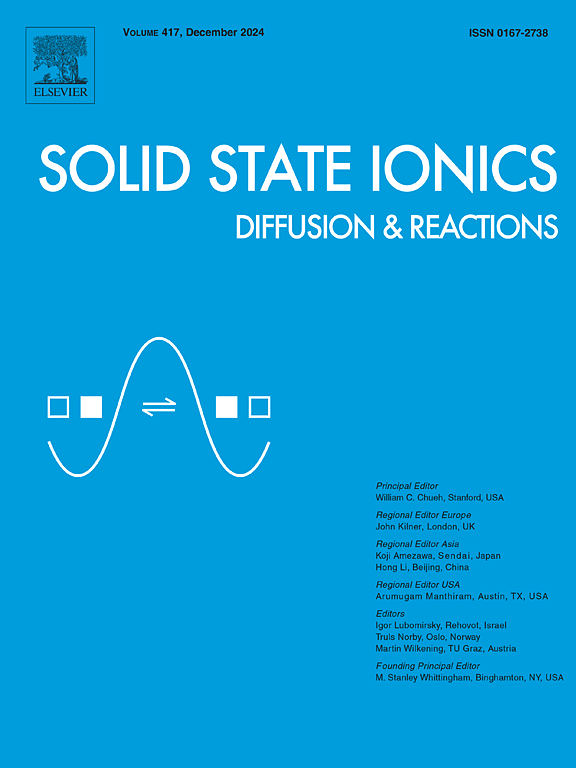High specific capacity O3-NaNi₁/₃Fe₁/₃Mn₁/₃O₂ cathode material for sodium-ion batteries
IF 3.3
4区 材料科学
Q3 CHEMISTRY, PHYSICAL
引用次数: 0
Abstract
Sodium-ion batteries (SIBs) have emerged as a promising alternative to lithium-ion batteries (LIBs) due to the abundance of sodium resources and lower material costs. O3-type layered oxides, particularly nickel‑manganese-based materials have a stable crystal structure. The preparation method of sodium-ion battery cathode materials is particularly crucial for their electrochemical performance. The conventional coprecipitation method imposes relatively stringent requirements regarding the concentrations of precipitants and complexing agents, as well as the inflow rate and pH control. Herein, the precursor of NaNi1/3Fe1/3Mn1/3O2 is prepared by the homogeneous co-precipitation, and the di-n-butylamine is used as the precipitant. Then O3-type NaNi₁/₃Fe₁/₃Mn₁/₃O₂ cathode material is obtained at calcination temperatures ranging from 800 °C to 900 °C. The sample calcined at 850 °C, exhibits lower Mn3+ content, which effectively suppresses the Jahn-Teller effect. Electrochemical tests demonstrates that at 0.1C and 1.5–4.3 V the initial discharge capacity of NNFM-850 is 155.11 mAh/g. The initial discharge capacity of NNFM-850 at 1C is 105.09 mAh/g and retained 79.35 % capacity after 100 cycles.
高比容量O3-NaNi₁/₃Fe₁/₃Mn₁/₃O₂钠离子电池正极材料
钠离子电池(SIBs)因其丰富的钠资源和较低的材料成本而成为锂离子电池(LIBs)的一个有前途的替代品。o3型层状氧化物,特别是镍锰基材料具有稳定的晶体结构。钠离子电池正极材料的制备方法对其电化学性能至关重要。传统的共沉淀法对沉淀剂和络合剂的浓度、流入速率和pH控制都有比较严格的要求。本文以二正丁胺为沉淀剂,采用均相共沉淀法制备了NaNi1/3Fe1/3Mn1/3O2前驱体。然后在800℃~ 900℃的煅烧温度下,制得o3型NaNi₁/₃Fe₁/₃Mn₁/₃O₂正极材料。850℃煅烧后的样品Mn3+含量较低,有效抑制了Jahn-Teller效应。电化学测试表明,在0.1C和1.5 ~ 4.3 V条件下,NNFM-850的初始放电容量为155.11 mAh/g。NNFM-850在1C条件下的初始放电容量为105.09 mAh/g,循环100次后容量保持79.35%。
本文章由计算机程序翻译,如有差异,请以英文原文为准。
求助全文
约1分钟内获得全文
求助全文
来源期刊

Solid State Ionics
物理-物理:凝聚态物理
CiteScore
6.10
自引率
3.10%
发文量
152
审稿时长
58 days
期刊介绍:
This interdisciplinary journal is devoted to the physics, chemistry and materials science of diffusion, mass transport, and reactivity of solids. The major part of each issue is devoted to articles on:
(i) physics and chemistry of defects in solids;
(ii) reactions in and on solids, e.g. intercalation, corrosion, oxidation, sintering;
(iii) ion transport measurements, mechanisms and theory;
(iv) solid state electrochemistry;
(v) ionically-electronically mixed conducting solids.
Related technological applications are also included, provided their characteristics are interpreted in terms of the basic solid state properties.
Review papers and relevant symposium proceedings are welcome.
 求助内容:
求助内容: 应助结果提醒方式:
应助结果提醒方式:


